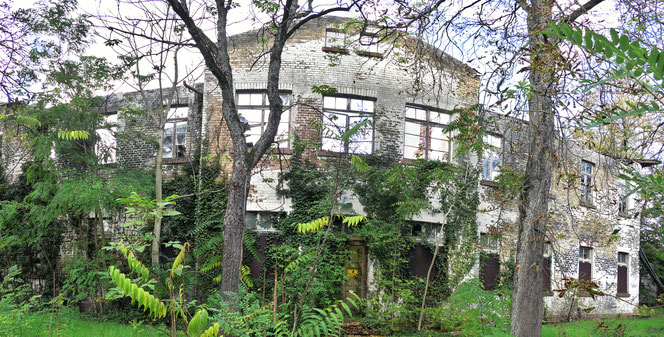August-Euler airfield and military-area
Originally, the more than 800 hectares of the former Griesheimer district "Griesheimer Sand" had dune character, whose steppe grassland vegetation is only partially preserved today and is a nature reserve. In the Middle Ages wine was grown here, later there was herb cultivation and seed trading.

In 1874 Griesheim leased part of the site to the Royal Preußische Ministry of War for an artillery firing range for the 11th Artillery Brigade. This changed the area - buildings, horse stables, storage rooms, shooting ranges were created, today's Flughafenstrasse and Jahnstrasse were created for development, and the area was even connected to the Darmstadt-Griesheim steam tram via a siding. The first Grand Ducal Hessian Field Artillery Regiment No. 25 was then based on the "Griesheimer Sand".
With the redesign of the 1908/1909 lease agreement, August Euler received a right of joint use, and the military set up an airfield.
Tests with manned gas balloons had already been carried out here in previous years.
Euler successfully carried out flight tests, which are considered a pioneering achievement. Thus, for the first time in Germany, an area was used for the purpose of regulated air traffic - it was the first airfield.
In 1910, Euler was the first German to acquire the international pilot's license.

In October 1910, August Euler set the German record for long-distance flight on the "Griesheimer Sand". The brother of the German Emperor, Prince Heinrich, also got his pilot's license from August Euler.
In 1911, the University in Darmstadt received a teaching position for airship travel.
In 1912 August Euler opened the Frankfurt airfield and relocated some of his activities there.
In that year, the first officially approved airmail carriage was carried out on the Frankfurt-Darmstadt-Worms-Mainz-Frankfurt route with Euler's flying machine No. 33 (Yellow Dog).


In 1912 the "Fliegerstation Griesheim" was set up by the Prussian army. A hangar was built in 1913, and a year later more than 50 aircraft from the air force and a repair shop were housed there.
Flight days were held, and the airfield was also involved in reliability competitions for German aircraft. But accidents and falls were also recorded.
At that time, the site was also used for infantry training and as an ammunition store, from 1914 barracks were built for a prisoner of war camp that could hold 10.000 prisoners and was fully occupied not long after the outbreak of war in 1915. After the First World War, the site served as a transit camp for returning German soldiers and was then used by the French occupiers as a military camp with a military training area (Camp de Griesheim).
In 1930 the Graf Zeppelin airship landed in Griesheim three times, and in 1932 the German Gliding Research Institute (DFS) moved here from the “Wasserkuppe”. In 1934, the commercial airport that had been created in the meantime on the “Lichtwiese” in Darmstadt was relocated to the “Griesheimer Sand” under the name Darmstadt Airport. The University Darmstadt, which had previously been able to use the space for research purposes, built a wind tunnel in 1935/36.
From 1936, training courses for the Luftwaffe began at Griesheim airfield, and the aviation engineering school opened the following year.
In 1937, the military training and military airfield in Griesheim was forcibly incorporated into Darmstadt.
In 1939, the DFS withdrew, the manufacture of gliders remained at the site (Jacobs-Schweyer Flugzeugbau GmbH). During World War II it became a Wehrmacht airport for research and aircraft production. There were also tests with jet aircraft. Allied bombs hit the facilities in 1940, 1943 and 1944, most recently with severe damage. Parts of the plant were blown up by the Wehrmacht towards the end of the war.
After the war, the airfield and the military training area were confiscated by the American troops and became the "Griesheim Army Airfield". Various rescue helicopter units (including the 72nd Liaison Squadron) were stationed here until 1992.


In 1980, the area used for smaller flight events was named "August-Euler-Flugplatz".
In 1992 the American army withdrew from the "Griesheimer Sand".
The site is now used by the University of Darmstadt and houses a small aviation museum, which was founded in 2005 by
the "Förderverein August Euler Luftfahrtmuseum e.V."
Quellen: Norbert Leber, Heimatverein Griesheim, Wikipedia, Darmstädter Echo



In 2007, in agreement between Mayor of Darmstadt, Walter Hoffmann and Mayor of Griesheim, Norbert Leber, a border regulation between Griesheim and Darmstadt took place, which led to a more logical allocation of the parts of the site.

Until 2008, the European edition of "The Stars and Stripes" daily newspaper was printed in a building on Griesheimer Sand.
In August 2008 organized by the University of Darmstadt in cooperation with the cities of Darmstadt and
Griesheim and the association, an anniversary celebration took place with an extraordinary air show "100 years of August-Euler-Flugplatz" at the "Griesheimer Sand", which was a great national
success.














The dilapidated buildings of the former barracks site have just been demolished by the city of Griesheim's development company, and the site is being replanned.





Eines der jetzt unbewohnten Wohnhäuser der amerikanischen Soldaten und eine alte Haltestelle.


Demolition of the old military buildings in 2021 - 2023
These old pictures show the buildings as they used to be.
-> Förderverein August-Euler-Flugplatz
-> Informationen der Stadt Griesheim zum Neubaugebiet
-> Informationen der Stadtentwicklungsgesellschaft Griesheim









































